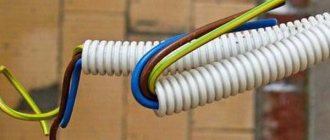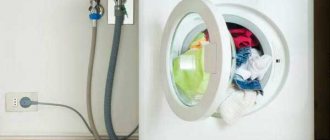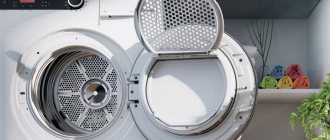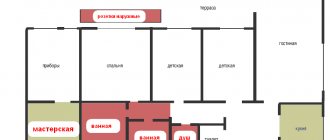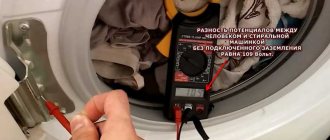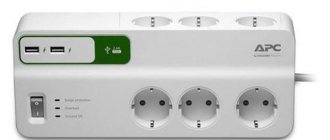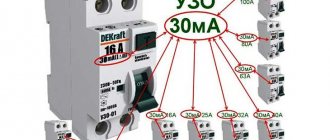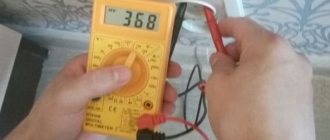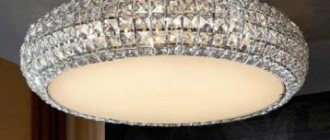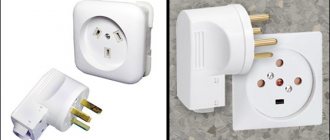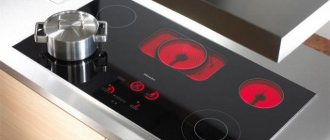Modern automatic washing machines belong to the class of household appliances with a high level of energy consumption. The maximum power consumption occurs during water heating and ranges from 2 to 3.5 kilowatts. Electrical wiring in many residential areas, especially early buildings, were not designed for such an amount of energy consumption. And today there is a washing machine in almost every apartment. Electrical overloads, power surges and other network faults can lead to a fire or breakdown of an expensive washing machine part. To protect household appliances, it is necessary to be responsible for the correct installation and connection of the device. It is cheaper to install a special circuit breaker in advance than to repair or buy a new washing machine.
Why do you need an RCD for a washing machine?
The washing machine is a powerful consumer that loads the wiring. That is why it is recommended to lay a separate power line and install automation. A TV or computer does not need a separate RCD, so why does it need to be installed on a washing machine? Working in conditions of high humidity automatically places it in a risk group, which means that special attention is required to ensure the safety of both the equipment itself and its users.
If we are talking about an expensive drying device, then one protective device will not be enough - you will need several. The maximum power consumption of the washing machine is 2.5–3 kW. This is a lot for old electrical networks - you can’t do without protection.
Reasons for triggering the ouzo
It is not often that the RCD trips when the washing machine is turned on, but it still happens sometimes. And in this case, you should not immediately call a specialist. You should first try to independently determine the reason for the operation of the protective device, and then decide what to do next.
There are a large number of reasons why an RCD is triggered, the most common of them are listed below:
- The residual current device is not selected correctly. If the RCD was selected without taking into account the characteristics of the washing machine, and its energy intensity is lower than necessary, then it will immediately turn off, perceiving the inclusion of more powerful equipment as a network overload;
- Problems with electrical wiring. Old or unsuitable electrical wiring may not be able to withstand the load, which can also lead to the machine tripping (in this situation, the RCD protects old or weak wiring from fire);
- Electricity leakage onto the equipment body. In this situation, if the neutral wire is connected to the housing and additional grounding is created, the protective device automatically turns off;
- A malfunction of the heating element, electric motor or surge protector, or shorted contacts and buttons can also trigger the RCD. In this situation, in the absence of knowledge in the field of electrical engineering, it is better to turn to specialists.
What other protection options are there?
RCDs are installed to protect people from electric shock, but they do not protect the electrical circuit from all possible risks. To prevent equipment breakdowns, an automatic circuit breaker is switched on in series with the RCD: it is designed to protect electrical circuits from short circuits and voltage surges.
How many amperes should the automatic protective equipment be designed for? Experts note the following pattern: when installing a device at 16 A, the RCD for the washing machine placed behind it must be designed for a higher current, for example 25 A. Protection can be provided in two ways:
- install an RCD and an automatic machine;
- installing a difavtomat is the best option.
Connection features
The selection and installation of a difavtomat in a washing machine must be carried out taking into account the RCD devices that are already available in the house or apartment. A number of designs can mutually exclude the use of each other, as a result of which, in the event of any malfunction, all electricity in the room will be turned off. A common practice is to use one RCD for all protected electrical circuits, but at the same time have some circuits that are not protected at all. A classic example: electrical sockets are usually on the RCD, but the lamp sockets are usually not; and other circuits vary depending on who installed the system and for what purpose. True, in modern buildings all protected elements are already connected to an RCD.
In its finished form, the equipment that provides protective shutdown can be of a block design and installed on a special service panel of the RCBO type in Europe. Such panels are more expensive, so if connected correctly, the difavtomat is usually the only external device that is connected to the RCD existing in the home. However, there is an exception. It concerns the arrangement of a grounding system in which the impedance of the ground loop can be quite high. This means that a ground fault may not generate enough current to trip a conventional or differential circuit breaker or a conventional fuse. In this case, a special RCD is installed with a trip current delay of 100 mA (or higher), which covers the entire circuit. Next, it is necessary to provide for the installation of more sensitive RCDs behind it; they will be needed to power outlets and other circuits that may be considered high-risk circuits.
In order to regularly confirm the performance of difavtomats, they can be periodically tested. For these purposes, solenoid voltmeters are used.
How does an RCD machine work?
The well-being of household appliances in our homes often depends on worn-out electrical substations that are not designed for heavy loads. One power surge is enough to lose all electrically powered devices in one fell swoop. To save washing equipment from the vagaries of electrical networks, it is provided with a separate RCD. It consists of:
- housings;
- transformer;
- chain breaking mechanism;
- self-diagnosis mechanism;
- electromagnetic cut-off - it is available in the latest generation models.
Triggering occurs at critical loads, the machine, opening the circuit, stops the flow of electric current - people and equipment are safe.
A dangerous situation will occur, for example, if a person touches exposed wires or if water gets on him. The automation, when activated, prevents electric shock and damage to expensive equipment. The sensor can be triggered many times and, unlike fuses, does not need to be changed.
Operating principle of the machine
In the standard version, the device has a housing made of plastic material, a transformer, a relay, a release, and a self-testing mechanism. New devices are additionally equipped with electromagnetic cut-offs.
In the normal state of the network, the relay device does not work, but when there is an increased load on the wiring, the built-in device will forcibly break the circuit, de-energizing it.
A similar situation is possible due to power surges or moisture getting on exposed wires. When the protection is triggered, there is no need to change it. The main difference between an RCD for a washing machine is that it is intended for repeated use.
How to connect a washing machine to the mains?
It’s not enough to buy a washing machine, you also need to connect it correctly. When all pipes are connected, electrical work begins. Installation rules:
- Do not use the washing machine without grounding.
- Do not use extension cords. It is also not recommended to use a special extension cord with an RCD.
- In rooms with a high moisture content, sockets must be installed in a moisture-proof housing.
- Connect the washing machine through a protective device.
Which RCD should I install on my washing machine?
The average user wants to know which protective device to install on the washing machine. Most models consume 2 kW, and this exceeds the nominal value of 10 A. Therefore, an automatic or automatic device must operate with an electric current greater than 10 A. Choose the 16 A option.
Among the important parameters of automatic protection is leakage current. The device reacts precisely to it. If the wiring is new, take the 10 mA option. For a circuit break to occur, the difference in current between phase and neutral must be 10 mA or more. If the wiring is old, use a 30 mA RCD to avoid erroneous shutdowns.
Another nuance that is important to pay attention to when choosing an automatic machine to connect to a washing machine is the manufacturer. There are two options:
- Expensive and high quality - Legrand or ABB.
- Budget - IEK.
These are the most famous companies on the market that produce protective automation. Chinese versions are cheaper, but they will not provide the reliability that European devices provide. If you select the wrong power and electric current, the plugs will be knocked out every time you start the machine.
We select an RCD according to 2 main parameters
A residual current device is a device that protects people and property from two dangers - fire and electric shock.
There are two types of residual current devices - differential circuit breaker or differential relay. Both of these devices are very similar and interchangeable. In the future, we will consider a differential relay (together with a machine) as a protective device as the most economical and flexible option.
By what parameters do you choose the right RCD? Differential protection devices differ in operating current and leakage current (or differential current).
For complete leakage protection, a joint circuit breaker is required.
What kind of automatic rifle do you need?
When making a choice, pay attention to the following parameters:
- Power. Corresponds to the power of the network (single- or three-phase).
- Voltage. For a single-phase network - 220 V, for a three-phase network - 380 V.
- Denomination In household networks, it is best to install machines marked with the letter “C”. For a network with a socket, option C 16 is preferable. Sometimes type C 25 is used.
- Built-in safety switch. Which washing machine to choose? It is recommended to take A-class. There is also an AC class, but this option is not so good for powerful loads.
- Additional protective automation. Lack of protection against wire breakage - zero, will cause the RCD to fail to operate if one of the wires malfunctions.
- Differential trip current. The best option is 30 mA. There are 10 mA ones - more expensive, their use is not rational.
Differential circuit breakers designed for current protection also disconnect the load when differential currents appear. The latter can appear during a breakdown of insulation on the housing - then the currents, inflows and outflows, are not the same. When this difference appears, the device breaks the circuit and electric shock is excluded. If a person touches live parts, the electric current flowing through him will not have time to grow to a dangerous value of 0.1 A.
Parameters and characteristics of difavtomats
To decide which RCD to install for a washing machine or water heater, first familiarize yourself with the basic parameters and characteristics of the device:
Depending on the network in which the difavtomat will be installed (single-phase or three-phase), a two-pole device (for an operating voltage of 220 V) or a four-pole device (380 V) is selected.
Please note that the rated operating voltage must be indicated on the device body
- Rated current. This is the amount of current, measured in amperes, that can pass through a switching device over a long period of time. The standard range of rated currents is as follows: 6, 10, 16, 20, 32, 40, 50, 63 A.
- Time-current characteristic (“B”, “C” or “D”), this parameter expresses the dependence of the response time of the machine on the current flowing through it.
- Rated differential current. This is the amount of current leakage to which the difavtomat will react and turn off. There is also a standard range of differential current - 10, 30, 100, 300, 500 mA.
- Rated breaking capacity. This parameter represents the maximum value of short circuit current that the differential circuit breaker is capable of switching off and remaining in working condition after that.
- Temperature Range. It usually varies from – 20 degrees to + 45.
All these parameters are indicated on the device body.
There you will find a connection diagram, the nominal frequency of the power supply (50 Hz), the type of built-in RCD (electronic or electromechanical).
Also, differential circuit breakers are of three types depending on the form of current leakage to which they react:
- “A” – for alternating sinusoidal and constant pulsating current forms.
- “AC” – for alternating sinusoidal current leakage.
- “B” – for alternating sinusoidal, constant pulsating and rectified forms of current leakage.
Installing a residual current device yourself
It is not difficult to install current protection. You will need a 3x2.5 mm VVG wire - it is pulled from the switchboard. The procedure is as follows:
- Using the indicator, phase and zero are determined.
- Connect the found conductors to the RCD.
- The wires are removed from the housing and the socket is connected to the RCD.
This is the simplest connection diagram. If, in addition to the washing machine, other consumers will be connected to the network, install an additional protective device. This will ensure uninterrupted operation for all consumers.
The difavtomat is installed in the same way. Thanks to this device, your washing machine will be reliably protected from dangerous power surges that can hopelessly damage any of its components - motor, control unit, pump, etc., and you - from electric shock.
When installing the washing machine in the bathroom, the outlet must be:
- moisture-proof;
- grounded.
If washing is in progress, it is better not to take a bath: if water splashes into the socket, a short circuit may occur and an electric shock may occur. After completing the cycle, remove the plug from the socket and close the lid of the socket tightly. All laid wires are protected with plastic corrugations. The wiring is located as high as possible from the floor. The ideal solution is a separate wire for the washing machine. Its minimum cross-section is 2.5 m². The socket and protective automatic equipment must be located so that in the event of a breakdown, the equipment can be easily switched off.
What to look for when choosing?
There are different extension cords in stores: with one, two sockets in a block or more, with or without an “On/Off” button, equipped with a voltage indicator and not. There are also models with a residual current device and grounding - they are considered the safest.
Since there is a possibility of leakage when the washing machine is operating, this means that water can get on the conductive parts of the extension cord. This increases the requirements for the device.
When choosing an electrical extension cord to connect an automatic machine, you should pay attention to the following characteristics:
- cable length, material of manufacture, core cross-section;
- number of sockets in the block;
- equipped with a grounding wire;
- the presence of a device that protects against short circuits in the network.
For example, if the washing machine consumes 2.5 kW, then the current indicator at a mains voltage of 220 Volts will be 11.4 A. Therefore, you will need a wire that can withstand a current of 16 Amps. This corresponds to a copper cable cross-section of 1.5 mm². The length of the cord should be from 3 to 7 meters.
The washing machine puts a serious load on the electrical extension cord, so you should not buy a device with several outlets. The ideal option is a block with one connector
It is important that there is a grounding wire, it is easy to find, it is colored yellow-green
Since the extension cord is usually used in bathrooms, which are areas with high humidity, it must meet IP20 protection against moisture and dust, as well as IP44, indicating that the device is insensitive to splashes.
It is imperative that the extension cord be equipped with fuses that protect against short circuits in the electrical circuit. This is necessary so that in the event of power surges, the device can absorb and neutralize the current surges.
The cost of an extension cord with grounding and a residual current device will be twice as high as the price of a model without these additions. However, in this case it is not worth saving - not only the safety of expensive equipment is at stake, but also the safety of your family.
Practical advice for installing difavtomats
New houses are equipped with grounded sockets and a panel with protective devices. All that remains is to select an outlet and find out which machine it is connected to. If there is an RCD there, it needs to be dismantled and a circuit breaker installed.
In old houses everything is much more complicated. There is no grounding, there is no automatic protection either. They start with installing the ground loop. Three galvanized pipes are installed near the house or in the basement. Their length is from 50 cm. The pipes are positioned so that they are the vertices of a triangle. If it doesn’t work out, you can do it on one straight line. A wire is screwed to one pipe using a bolt - it is pulled into the apartment, to the panel.
The European socket for the washing machine is connected to the automatic machine installed in the panel specifically for this purpose. The device is selected taking into account the current consumed by the equipment. It is determined based on the rated power. Power, kW, is divided by voltage, V. Then 20% is added - this will be the average current. Take the option with a current equal to the calculated value or slightly greater.
Installation required
The machine will provide reliable protection for electrical wiring and the device itself. The washing machine is considered one of the largest consumers of energy and creates a significant load on the wires. In addition, the device operates in a “wet” environment, which puts it in a high-risk group and requires good protection.
Based on this, experienced specialists recommend installing an RCD for a washing machine in order to maintain the functionality of the device, protect residents from electric shock, and protect property from fire.
Example of calculating a difavtomat
Initial data:
- Power consumption - 2.2 kW.
- Rated current - 10 A.
20% margin = 2 A. It turns out that for a 2.2 kW washing machine you will need a device with 12 A or more. The best option is a shutdown current of 15 A. Choose the closest value. If 12 A comes out, you cannot install a 40 A device. This is dangerous for equipment. The differential shutdown current is 30 mA, no more.
Why are extension cords banned?
The power wires transmit power of more than 2 kW. Therefore, all disconnecting connections must ensure perfect contact. This is possible with European sockets that have a large area of contacting contacts. But this cannot be done without losses, and extension cords only increase them. The consequence of losses is heating. Extension cords are often plugged into regular sockets - with the help of adapters, losses increase even more. Due to constant heating, contacts burn and plugs and sockets deteriorate. As a result, a fire occurs.
